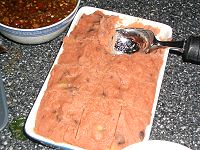| ||||||||||||||||||||||||||||||
| ||||||||||||||||||||||||||||||
| ||||||||||||||||||||||||||||||
The mung bean is one of many species recently moved from the genus Phaseolus to Vigna, and is still often seen cited as Phaseolus aureus or Phaseolus radiatus. These variations of nomenclature have been used regarding the same plant species.
Contents
|
Uses
Whole mung beans are generally prepared from dried beans by boiling until they are soft. In Chinese cuisine, whole mung beans are used to make a tángshuǐ, or dessert, otherwise literally translated, "sugar water", called lǜdòu tángshuǐ, which is served either warm or chilled. In Indonesia, they are made into a popular dessert snack called es kacang hijau, which has the consistency of a porridge. The beans are cooked with sugar, coconut milk, and a little ginger. Although whole mung beans are also occasionally used in Indian cuisine, beans without skins are more commonly used; but in Kerala, whole moong dal (cheru payaru) is commonly boiled to make a dry preparation often served with rice gruel (kanji). In the Philippines, it is the main ingredient of the dessert hopiang munggo. A savory soup called ginisang monggo, made of mung beans and shrimp, is normally served on Friday evenings, as the majority of the Filipino population are Roman Catholic, and traditionally abstain from meat on Fridays, even outside of Lent.
Whole beans
Mung beans are light yellow in color when their skins are removed.[2] They can be made into mung bean paste by dehulling, cooking, and pulverizing the beans to a dry paste.[2] In Hong Kong, dehulled mung beans and mung bean paste are made into ice cream or frozen ice pops.[2] Mung bean paste is used as a common filling for Chinese mooncakes in East China and Taiwan.[2] Also in China, the boiled and shelled beans are used as filling in glutinous rice dumplings eaten during the dragon boat festival (端午节).[2]Dehulled mung beans can also be used in a similar fashion as whole beans for the purpose of making sweet soups. Mung beans in some regional cuisines of India are stripped of their outer coats to make mung [[dal]]. In Tamil Nadu and Andhra Pradesh, steamed whole beans are seasoned with spices and fresh grated coconut in a preparation called sundal. In south Indian states, mung beans are also eaten as pancakes. They are soaked in water for six to 12 hours (the higher the temperature, the lesser soaking time). Then they are ground into fine paste along with ginger and salt. Then pancakes are made on a very hot griddle. These are usually eaten for breakfast. This provides high quality protein in a raw form that is rare in most Indian regional cuisines. Pongal or kichdi is another recipe that is made with rice and mung beans without skin.
In Kerala, it is commonly used to make the parippu preparation in the Travancore region (unlike Cochin and Malabar, where toor dal, tuvara parippu, is used). It is also used, with coconut milk and jaggery, to make a type of payasam.
In India, dal moth is a snack using mung beans.[2] The method involves using dried mung beans that have been soaked in water, and then partly drying them to a dry matter content of about 42%. Afterwards, they are deep-fried for about 60-90 seconds in hot oil. The snack has about 20% of fat content. The snack is traditionally prepared at home, but is also available commerically.[2]
Bean sprouts
Mung bean sprouts are germinated by leaving them watered with four hours of daytime light and spending the rest of the day in the dark. Mung bean sprouts can be grown under artificial light for four hours over the period of a week. They are usually simply called "bean sprouts," and are known as dòuyá (豆芽) in Mandarin; yácài (芽菜, literally "sprout vegetable"), or yínyá (銀芽, literally "silver sprouts") in Chinese; and hokkien (min nan), ပဲတီပင်ပေါက် or pe ti pin pauk in Burmese, sukju namul in Korean, moyashi (萌やし) in Japanese, tauge in Indonesian, Malay, and Singlish (from Hokkien tāu-gê) , togue in Filipino, thua-ngok (ถั่วงอก) in Thai, and giá đậu or giá đỗ in Vietnamese.Mung bean sprouts are stir-fried as a Chinese vegetable accompaniment to a meal, usually with ingredients such as garlic, ginger, spring onions, or pieces of salted dried fish to add flavor. Uncooked bean sprouts are used in filling for Vietnamese spring rolls, as well as a garnish for phở. They are a major ingredient in a variety of Malaysian and Peranakan cuisine, including char kway teow, hokkien mee, mee rebus, and pasembor. In Korea, slightly cooked mung bean sprouts, called sukjunamul (hangul: 숙주나물), are often served as a side dish. They are blanched (placed into boiling water for less than a minute), immediately cooled in cold water, and mixed with sesame oil, garlic, salt, and often other ingredients. In the Philippines, mung bean sprouts are made into lumpia rolls called lumpiang togue.
Mung bean sprouts are the major bean sprouts in most Asian countries. In China and Korea, soybean sprouts, called kongnamul (hangul: 콩나물) are more widely used in a variety of dishes.












No comments:
Post a Comment